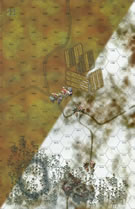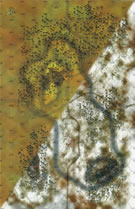It Was Jolly Cold: Grimbiémont, East of Marche, Belgium
Britain's Bulge #10
|
|
(Attacker)
Britain
|
vs |
Germany
(Defender)
|
|
Total |
| Side 1 |
1 |
| Draw |
0 |
| Side 2 |
0 |
|
Total |
| Side 1 |
1 |
| Draw |
0 |
| Side 2 |
0 |
|
Total |
| Side 1 |
0 |
| Draw |
0 |
| Side 2 |
0 |
| Overall Rating, 1 vote |
|---|
|
|
|
Scenario Rank:
--- of 913 |
| Parent Game |
Britain's Bulge |
| Historicity |
Historical |
| Date |
1945-01-07 |
| Start Time |
12:00 |
| Turn Count |
14 |
| Visibility |
Day |
| Counters |
34 |
| Net Morale |
0 |
| Net Initiative |
2 |
| Maps |
2: 22, 25 |
| Layout Dimensions |
56 x 43 cm
22 x 17 in |
| Play Bounty |
166 |
| AAR Bounty |
227 |
| Total Plays |
1 |
| Total AARs |
0 |
|
Introduction
|
|
The German 116th Panzer-Division remained entrenched in the wooded hills around Grimbiémont, three miles southeast of Marche. On 7 January the British resumed their advance; on the right of the 158th Brigade sector, the 1st East Lancashire cleared up the forest towards the Hedrée Brook, but found the enemy strongly entrenched on the high ground at Grimbiémont on the opposite side of the valley. At noon the East Lancs attacked uphill over open sloping ground towards Grimbiémont to seize the village, nestled behind the ridge.
|
|
Conclusion
|
|
The British harbored for the night in a large wood on the top of some high ground, captured from the enemy the day before. The wood stretched toward the Germans and the ground gradually sloped away in the same direction, until the wood ended in a shallow valley. From the edge of the wood and across the valley one could see a long stretch of open snow, with the ground rising to a ridge in the rear. H Hour was fixed at 1200 and the operational planning included artillery support to lay down smoke to mask the tanks’ movements. However, the first four tanks leading the way had first to cross a small stream but as soon as they did, they sank right down into a bog which had been completely hidden by the snow. Meanwhile, the infantry had gone in without any armored support and met determined opposition mainly from mortar and very accurate artillery fire. They therefore made less progress than had been expected. The left forward infantry company battled three Panzer IV tanks that had taken up hull-down positions on the forward edge of the woods to the east of the village.
Luckily for the battalion, it started to snow that afternoon which somewhat concealed the battalion's advance. Fighting the panzers with their PIATs, the British scored a direct hit on one of the tanks which jammed the turret. The remainder withdrew and this permitted the company to continue the attack. After that, every house had to be systematically cleared. The rest of the supporting British tank squadron at last extricated itself from the woods and bogs and came out on a road on the right flank. They were having difficulty in climbing the hill due to the usual frozen surface but they made it to the top after slipping and sliding from side to side. By about 1400 the infantry had reached the village and the tank squadron was with them, consolidating. A total of 180 POWs were captured during the day, all members of the 116th Panzer Division. Both battalions of the 158th Brigade suffered severe losses. The 1st East Lancs on 7 January suffered 19 killed and 75 wounded; in their three days of action in the Ardennes Lt. Col. Alan Jolly’s battalion lost a total of 11 officers and 232 men killed, wounded and missing. News arrived that the 51st Highland Division would relieve the 53rd Welsh Division on the next day (8 January). This resulted in a break in the British advance.
|
Display Relevant AFV Rules
| AFV Rules Pertaining to this Scenario's Order of Battle |
- Vulnerable to results on the Assault Combat Chart (7.25, 7.63, ACC), and may be attacked by Anti-Tank fire (11.2, DFT). Anti-Tank fire only affects the individual unit fired upon (7.62, 11.0).
- AFV's are activated by tank leaders (3.2, 3.3, 5.42, 6.8).
They may also be activated as part of an initial activating stack, but if activated in this way would need a tank
leader in order to carry out combat movement.
- AFV's do not block Direct Fire (10.1).
- Full-strength AFV's with "armor efficiency" may make two anti-tank (AT) fire attacks per turn
(either in their action segment or during opportunity fire) if they have AT fire values of 0 or more
(11.2).
- Each unit with an AT fire value of 2 or more may fire at targets at a distance of between 100% and 150% of its
printed AT range. It does so at half its AT fire value. (11.3)
- Efficient and non-efficient AFV's may conduct two opportunity fires per turn if using direct fire
(7.44, 7.64).
Units with both Direct and AT Fire values may use either type of fire in the same turn as their opportunity fire,
but not both (7.22, 13.0).
Units which can take opportunity fire twice per turn do not have to target the same unit both times (13.0).
- Demoralized AFV's are not required to flee from units that do not have AT fire values (14.3).
- Place a Wreck marker when an AFV is eliminated in a bridge or town hex (16.3).
- AFV's do not benefit from Entrenchments (16.42).
- AFV's may Dig In (16.2).
- Closed-top AFV's: Immune to M, M1 and M2 results on Direct and Bombardment Fire Tables. Do not take step losses from Direct or Bombardment Fire. If X or #X result on Fire Table, make M morale check instead (7.25, 7.41, 7.61, BT, DFT).
- Closed-top AFV's: Provide the +1 modifier on the Assault Table when combined with infantry. (Modifier only applies to Germans in all scenarios; Soviet Guards in scenarios taking place after 1942; Polish, US and Commonwealth in scenarios taking place after 1943.) (ACC)
- Tank: all are closed-top and provide the +1 Assault bonus, when applicable
- Armored Cars: These are Combat Units. They are motorized instead of mechanized. All have their own armored car leaders, who can only activate armored cars (6.85). Do not provide the +1 Assault bonus (ACC).
- Reconnaissance Vehicle: 8.23 Special Spotting Powers Both foot and vehicle mounted recce units (1.2) possess two special spotting abilities. The first ability is that they can spot enemy in limiting terrain at one hex further than the TEC specifies for other units and leaders. For example, an enemy unit in town can normally be spotted at three hexes or less, but a recce unit can spot them at four hexes.Their second ability is that they can place a Spotted marker on any one enemy unit they can spot per turn, just as if the enemy unit had "blown its cover" by firing. Such Spotted markers are removed as described earlier.
|
| 2 Errata Items |

|
The reduced direct fire value of the Heer HMG became 5-5 starting with Fall of France.
|

|
All SS PzIVH tanks should have a movement of 8.
|




 BBoB009
BBoB009 


















